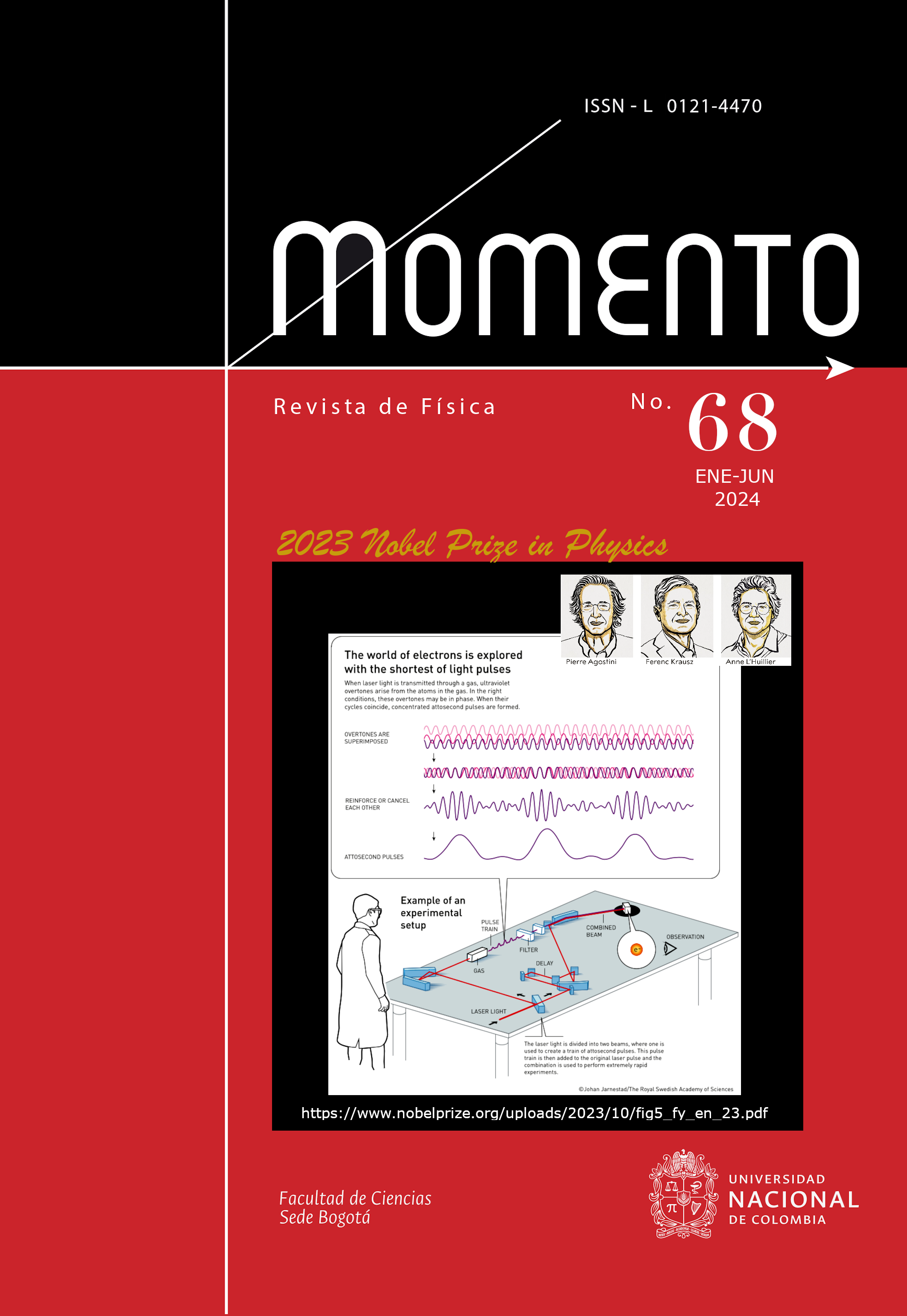CROSS SECTION ESTIMATION FOR HEAVY ION NUCLEAR REACTIONS WITH A CASCADE CODE OF FUSION EVAPORATION
ESTIMACIÓN DE SECCIONES EFICACES PARA REACCIONES NUCLEARES DE IONES PESADOS CON UN CÓDIGO DE CASCADAS DE FUSIÓN EVAPORACIÓN
DOI:
https://doi.org/10.15446/mo.n68.106810Keywords:
PACE, nuclear reaction, fusion-evaporation, decay cascade (en)cascada de decaimientos, PACE, reacción nuclear, fusión-evaporación (es)
Downloads
This article presents a study of fusion-evaporation nuclear reactions. Starting from a detailed description of the semi-classical theoretical framework behind this nuclear reaction, quantities such as the cross section of compound nucleus formation and various evaporation residues after its formation, as well as their cross sections (proportional to the events number), were estimated by means of a Python code. The code splits the compound nucleus formation process and its subsequent decay into several residual nuclei, which occurs as a sequential particle emission. In order to prioritize a first approximation theory, different nuclear models, with semi-classical and statistical origin, related to projectile-target fusion, light particle evaporation (n, p, α) and fission, were described in detail.
The values obtained with the computational routine developed were compared with experimental values and results from the PACE code. Cross sections were calculated for about 90 proposed reactions that produce residues with excess protons. In general, the results obtained show significant discrepancies, especially in heavy nuclei reactions, although some agreements are found even taking into account the limitations of the code. The main reason for this discrepancy may be associated with the lack or overestimation of some channels which may affect the proportion of events. This motivates a more sophisticated analysis in the future that could allow a wider range of channels.
En este artículo se presenta un estudio de las reacciones nucleares de fusión-evaporación. Partiendo de una descripción detallada de la teoría semi-cl´asica detrás de la reacción, se estimaron cantidades como la sección eficaz de formación del núcleo compuesto y diferentes residuos de la evaporación después de su formación, así como sus secciones eficaces (proporcionales al número de eventos), por medio de un código de Python. El código divide el proceso de formación del núcleo compuesto y su posterior decaimiento en varios núcleos residuales, lo que ocurre como una emisión secuencial de partículas. Para priorizar una descripción de primera aproximación, la teoría recopilada aborda diferentes modelos nucleares, de origen semi-clásico y estadístico, relacionados a los procesos de fusión proyectil-blanco, evaporación de partículas ligeras (n, p, α) y fisión.
Los valores obtenidos con la rutina computacional desarrollada se compararon con valores experimentales y resultados provenientes del c´odigo PACE. Se calcularon las secciones eficaces para alrededor de 90 reacciones propuestas que producen residuos con exceso de protones. Los resultados obtenidos, en general, muestran notables discrepancias, sobre todo en reacciones de núcleos pesados, aunque se encuentran diversas coincidencias incluso teniendo en cuenta las limitaciones del código. La razón principal para esta discrepancia puede estar asociada a la falta o sobreestimaci´on de ciertos canales que puedan alterar la proporci´on de los eventos. Esto motiva una análisis más sofisticado en el futuro que pueda permitir una mayor variedad de canales.
References
A. Lightfoot, Analysis of the charge state distribution produced in a 78Kr + 98Mo fusion evaporation reaction utilizing the MARA separator (master thesis) (University of Jyväskylä, Finland, 2016). https://jyx.jyu.fi/bitstream/handle/123456789/51817/URN:NBN:fi:jyu-201611034564.pdf?isAllowed=y&sequence=1
E. Khaleel, Study of fusion evaporation channels in the 18O + 18O reaction at 65 MeV (master thesis) (Stellenbosch University, South Africa, 2011). https://core.ac.uk/download/pdf/37344866.pdf
K. Krane, Introductory Nuclear Physics (John Wiley & Sons, Inc., 1988). https://books.google.com.co/books/about/Introductory_Nuclear_Physics.html?id=ConwAAAAMAAJ&redir_esc=y
A. Kamal, Nuclear Physics (Springer-Verlag Berlin Heidelberg, 2014). https://books.google.com.co/books/about/Nuclear_Physics.html?id=8G31AwAAQBAJ&redir_esc=y
P. Fröbrich and R. Lipperheide, Theory of Nuclear Reactions (Oxford University Press Inc., 1996). https://books.google.com.co/books/about/Theory_of_Nuclear_Reactions.html?id=fFLhwE9C-qAC&redir_esc=y DOI: https://doi.org/10.1093/oso/9780198537830.001.0001
R. Bass, Phys. Rev. Lett. 39, 265 (1977). http://dx.doi.org/10.1103/PhysRevLett.39.265
B. Blank, G. Canchel, F. Seis, and P. Delahaye, Nucl. Instrum. Methods Phys. Res. B 416, 41 (2018). http://dx.doi.org/ https://doi.org/10.1016/j.nimb.2017.12.003
O. Tarasov and D. Bazin, Nuclear Instruments and Methods in Physics Research Section B: Beam Interactions with Materials and Atoms 266, 4657 (2008). http://dx.doi.org/https://doi.org/10.1016/j.nimb.2008.05.110
A. Gavron, Phys. Rev. C 21, 230 (1980). http://dx.doi.org/10.1103/PhysRevC.21.230
LISE++ group from NSCL-MSU, “PACE4: GUI evaporation code. http://lise.nscl.msu.edu/pace4.html,” (2021). http://lise.nscl.msu.edu/pace4.html
D. Castiblanco, Estimación de cantidades físicas involucradas en reacciones nucleares de fusión y transferencia de nucleones (unpublished bachelor thesis) (Universidad Nacional de Colombia, Colombia, 2022). https://books.google.com.sv/books?id=VzDpBwAAQBAJ
A. J. Cole, Statistical Models for Nuclear Decay: From Evaporation to Vaporization, Fundamental and Applied Nuclear Physics (IOP Publishing Ltd., 2000). https://books.google.com.sv/books?id=VzDpBwAAQBAJ
National Nuclear Data Center, “NuDat 3.0 database,” Consulted in January 22, 2022. (2019). https://www.nndc.bnl.gov/nudat/
C. Y. Wong, Phys. Rev. Lett. 31, 766 (1973). http://dx.doi.org/10.1103/PhysRevLett.31.766
A. J. Sierk, Phys. Rev. C 33, 2039 (1986). http://dx.doi.org/10.1103/PhysRevC.33.2039
G. Henning, “A python reimplementation of A. Sierk’s BARFIT,” (2021), working paper or preprint. https://hal.archives-ouvertes.fr/hal-03132426
A. Gilbert and A. G. W. Cameron, Can. J. Phys. 43, 1446 (1965). http://dx.doi.org/10.1139/p65-139
H. Lu, A. Marchix, Y. Abe, and D. Boilley, Comput. Phys. Commun. 200, 381 (2016). http://dx.doi.org/10.1016/j.cpc.2015.12.003
D. Castiblanco, “fus-evap-code (GitHub repository). https://github.com/ddcastiblancoc/fus-evap-code
How to Cite
APA
ACM
ACS
ABNT
Chicago
Harvard
IEEE
MLA
Turabian
Vancouver
Download Citation
License

This work is licensed under a Creative Commons Attribution-NoDerivatives 4.0 International License.
Those authors who have publications with this journal, accept the following terms:
a. The authors will retain their copyright and will guarantee the publication of the first publication of their work, which will be subject to the Attribution-SinDerivar 4.0 International Creative Commons Attribution License that permits redistribution, commercial or non-commercial, As long as the Work circulates intact and unchanged, where it indicates its author and its first publication in this magazine.
b. Authors are encouraged to disseminate their work through the Internet (eg in institutional telematic files or on their website) before and during the sending process, which can produce interesting exchanges and increase appointments of the published work.




















